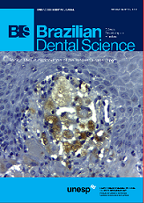Evaluation of masticatory and salivary parameters in preschool children with different morphological occlusion
DOI:
https://doi.org/10.14295/bds.2017.v20i2.1374Resumo
Objective: To better understand the relationship between malocclusion and masticatory and salivary functions in the primary dentition, the aim was to evaluate the differences in masticatory performance (MP), facial morphology (FM), maximal bite force (BF) and salivary parameters in 65 preschool children with normal occlusion (n = 22), functional posterior crossbite (n = 20) and anterior open bite (n = 23), and to explore the relationship between these variables. Material and Methods: MP, FM and BF were assessed by sieving method, anthropometry and gnatodynamometer, respectively. Stimulated (SS) and unstimulated (US) saliva flow and composition were measured by automated colorimetric technique. Data were analyzed using ANOVA/Kruskal-Wallis, t-test/Wilcoxon and Pearson/Spearman correlation test. The relationship between SS flow rate and the independent variables were assessed using multiple linear regression. Results: The lower face dimension was smaller in crossbite-group, and a decreased BF in the crossbite-side of the dental arch was observed. BF correlated positively with intergonial width in open bite group. In malocclusion groups, better MP correlated with byzigomatic and intergonial widths. US flow rate was lower in crossbite-group and total protein concentration differed between SS and US saliva only in the crossbite-group, being lower in US. Amylase activity was higher in SS than US in all groups. SS flow rate related positively with age and negatively with the presence of malocclusion. Conclusion: In young subjects, significant correlations were found between masticatory parameters and facial dimensions; in addition, some important masticatory and salivary parameters differed between children with different morphological occlusions, hence the importance of the early assessment of these parameters.
KEYWORDS
Bite Force; Dental Occlusion; Masticatory System; Primary Dentition.
Downloads
Downloads
Arquivos adicionais
Publicado
Como Citar
Edição
Seção
Licença
TRANSFERÊNCIA DE DIREITOS AUTORAIS E DECLARAÇÃO DE RESPONSABILIDADE
Toda a propriedade de direitos autorais do artigo "____________________________________________________________________" é transferido do autor(es) para a CIÊNCIA ODONTOLÓGICA BRASILEIRA, no caso do trabalho ser publicado. O artigo não foi publicado em outro lugar e não foi submetido simultaneamente para publicação em outra revista.
Vimos por meio deste, atestar que trabalho é original e não apresenta dados manipulados, fraude ou plágio. Fizemos contribuição científica significativa para o estudo e estamos cientes dos dados apresentados e de acordo com a versão final do artigo. Assumimos total responsabilidade pelos aspectos éticos do estudo.
Este texto deve ser impresso e assinado por todos os autores. A versão digitalizada deverá ser apresentada como arquivo suplementar durante o processo de submissão.




























